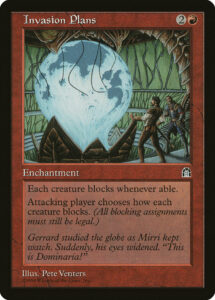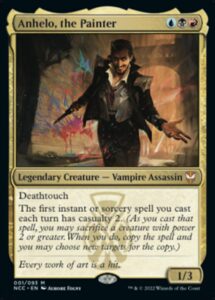Streets of New Capenna is a fascinating set. It may be the only Premier set in contemporary Magic history to be directly built upon another set’s skeleton (Khans of Tarkir). It’s proved a rather contentious Limited environment due to imbalances among colors, archetypes, and mechanics. And it has the unfortunate duty of needing to hold player attention for over four months—a nearly impossible task, especially given Double Masters 2 high price and low print run and Commander Legends 2 being for only part of SNC’s audience made both sets unable to create much slack.
These issues, especially the Limited imbalances, made it harder for the set’s mechanics to shine. So today, we’re going to review all five new mechanics in Streets of New Capenna. This will give us a better understanding of the set’s intents, successes, and shortfalls.
Initial overview
Before Streets of New Capenna even came out, I was struck by how Spike-centric its mechanics are. Connive, Exploit, and Blitz all demand a choice from the player, almost always right when they cast the spell. They all let you spend another resource to improve or modify the mechanic’s effect. And with all of them, ignoring that additional value (or in the case of Exploit and Blitz, ignoring the mechanic entirely) can be the best move. We’ve seen similarly Spike-y faction mechanics before, as with Surveil in Guilds of Ravnica, but never in so great a number and with so much immediacy.
I believe this mechanical setup makes a set harder for less experienced players to approach the set—Kicker has a simple heuristic where if you can pay the extra cost, you almost always should. With Blitz and Exploit, there is no such simple rule of thumb, nor is there as straightforward a heuristic for Connive (unless you’re talking about an Echo Inspector, where Flying magnifies the value of the +1/+1 counter).
Having one Spike-y mechanic can be great, but having 60% of all mechanics strikes me as both excessive and liable to make Play Design’s job more difficult. When so many mechanics are defined about eking out small advantages through immediate decisions (with the possibility of additional synergies), it can be easy to both overwhelm players with choice fatigue and miss the mark on power level.
I wanted to cover that before talking about each individual mechanics, since it’d otherwise come up for all three. But before we get into each primary mechanic, let’s talk about the design of the two color archetypes.
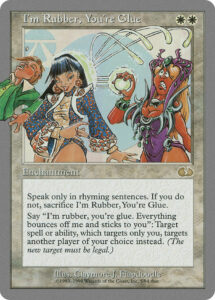
When the glue doesn’t connect as intended
Streets of New Capenna design teams worked hard to create synergy between crime families. In Khans of Tarkir, the clans didn’t really synergize each other—the set was built around Morph, which bridged mechanical and color gaps. In SNC, all five allied color pairs were supported. This is a noble goal to both reign in complexity (so there needn’t be a sixth mechanic) and increase the number of archetypes (a major boon in sets with only five archetypes).
The execution proved somewhat problematic. Adding two color creatures more powerful than the three color payoffs undermined the set’s stated goal of being about three color factions, but that’s a power level issue, not a design one. I have bigger issues with these mini-archetypes themselves, since those are Vision and Set Design choices.
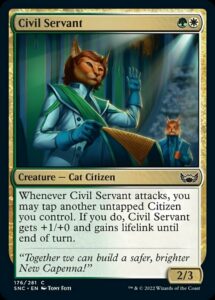
There’s a reason Magic does more species-tribal than job-tribal: it’s much easier to tell a goblin from a human than it is a soldier from a warrior. We still have job-tribal in sets like Zendikar Rising, but the entire set is structured around them. If a creature looks like it fights, it almost certainly is the one martial class featured in the set. But there have been almost no citizens in Magic before Streets of New Capenna. I couldn’t tell you why Disciplined Duelist is a citizen and Celebrity Fencer isn’t.
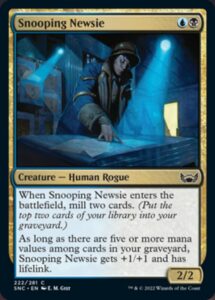
In player psychology, people are generally good at holding three things in their head at once. Give them too many things to focus on, and they struggle. This was part of the issue with Threshold back in Odyssey—there could be too many moving pieces to track. That isn’t to say that players don’t enjoy using their brains (that’s part of the joy of Magic!), but you want to give them manageable cognitive loads that are fun to think about.
Wizards updated the Threshold mechanic with Delirium, which helpfully only requires counting to four—essentially counting to three, as you go 1, 2, 3, done! Here, the threshold of five is too high to be easily tracked. And unlike Delirium, a major set mechanic, this unnamed version is barely supported. It demands a nontrivial amount of mental energy for an effect that infrequently comes up, just like paying attention to which creatures are citizens.
I feel like Wizards had already learned the issues of both this mechanic from Odyssey and citizen tribal from Morningtide. Yet they still put them into sets with already high cognitive loads at minimal volume. I don’t think that helped the mechanics shine or improve the overall set experience.
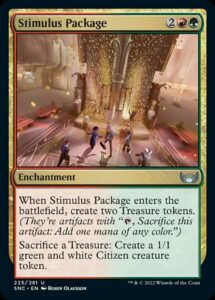
Finally, there’s RG Treasure. It had interesting applications with specific cards, but suffered due to having no relation to anything else in the set. Instead of providing glue to red, the color which happened to be the weakest in the set, it provided a random other direction to go in—one that also didn’t quite hit the mark.
I’m less critical on the decision to create this than I am the GW and UB mechanics, but it does underscore the risks of having an undersupported archetype when all four other mini-mechanics aim to create synergy. You may create a nonfunctional subarchetype while undermining one of the intended primary archetypes.
With all that out of the way, let’s get into the actual mechanics of the set. They’re all fairly simple (if Spike-heavy, as mentioned previously), there are five to cover, and SNC’s issues seem more structural to me than particular to any mechanic; so we’ll go through them at more of a canter than a trot.
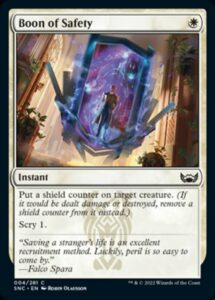
A new form of protection
Shield counters are extremely reminiscent of Totem Armor, though they play a bit better by virtue of being a bit weaker—any damage knocks them off, rather than just lethal damage. As a mechanic with inherent card advantage, they can be hard to balance. Dapper Shieldmate felt like a great way to redesign Giant Cockroach, while Disciplined Duelist was miserable to play against.
Personally, shield counters struck me as fine, but unexciting. They were powerful and easy to use, a nice boon in a complex set, but that’s all they did. They’re dangerous to use on overly large creatures or defensive creatures, and they require the use of punch-out counters in tabletop play. I could see the mechanic returning as a less confusing twist on Protection, but it has its own costs and risks.
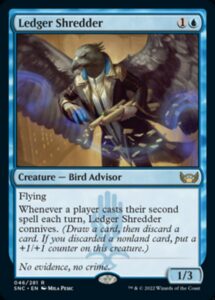
The new Explore
I covered Connive when it was first previewed. It’s a twist on Explore, where you have near-total control over the +1/+1 counter, but at the cost of power. I was never a fan of Explore, mostly due to creatures like Siren Lookout where the difference between randomly hitting the +1/+1 counter and missing was often the difference between victory and defeat.
Having played with Connive, I appreciate Explore more than I used to. I prefer Connive, but Explore gives you far less to think about and is more exciting to resolve. I could see Connive returning as the Dimir mechanic in a Ravnica set or an enabler in Modern Horizons, but it seems a little choice-heavy and power-light for a Premier set. It’s an unusual smoothing mechanic in that it encourages you to discard spells and keep lands when you normally wouldn’t want to, which could make it excellent in a Landfall set. But an interesting design is not necessarily a fun one.
So, I like it for being a blue mechanic that rewards playing creatures and can buff them, but it has more issues than I initially anticipated.
Trading tempo for power
Casualty is the other mechanic I dove into before SNC released. Having played with it, it has many elements I enjoy. It’s a spell mechanic that rewards aristocrats-style sacrificing and has plenty of modularity. It synergizes beautifully with Blitz, helps enable the UB threshold theme, and presents an array of interesting deckbuilding and in-game decisions. It even works with the (admittedly underpowered) Exploit creatures from Innistrad: Crimson Vow.
My biggest concern with Casualty is design space. It turns out, any Casualty number higher than 1 was a massive cost in SNC Limited. Even in a slower format, Casualty 3 is just an enormous cost to pay. A Casualty 3 spell would likely need to be far too powerful to compensate you for sacrificing a Binding Geist or Selfless Cathar. And there probably aren’t too many spell effects which can be balanced to Casualty 1.
Beyond that, the preponderance of sacrifice archetypes in Magic has mostly invalidated Pacifism effects—even if there is a deep design vein of Casualty cards, Magic may way to be judicious in using them to preserve the design space of defensive auras. I appreciate the knobbiness of Casualty’s design and its interesting play patterns, but its likely narrow design space makes it perfect as a faction mechanic in a set like SNC rather than a mechanic we’ll see time and again.
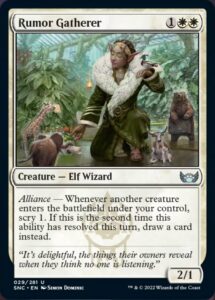
Non-tribal allies
Alliance had the biggest balance issues in Streets of New Capenna. Very few cards bore the mechanic and most were very weak in Limited. But setting those Play Design considerations aside, I think the mechanic has big structural issues.
First, the deckbuilding challenge is fairly facile. Limited decks already want to play lots of creatures, so the only cost is sacrificing removal spells or combat tricks to play even more creatures and the only challenge is finding token generations to get even more Alliance triggers.
Second, Alliance triggers generally need to be worth a fraction of a card. Designers need to assume you can reliably trigger Alliance each turn, possibly multiple times each turn, so the effect must be miniscule. There just aren’t that many tiny effects that function and are fun in multiples, and even staple effects like “target creature gets +1/+0” can make combat too dangerous when Flash creatures or Raise the Alarm are around. This inhibits the design space to a fairly tiny array of options. Alliance can and does circumvent that issue on Rumor Gatherer (which has a scaling trigger) and Celebrity Fencer (which costs a lot of mana and is understatted), but they bring their own problems in the form of clunky rules text and awkward sequencing.
I see Alliance as a less interesting form of Landfall. It provides fewer deckbuilding incentives, requires more caution than Landfall because it’s easier to trigger twice in a turn, and requires even more caution because it synergizes with itself.
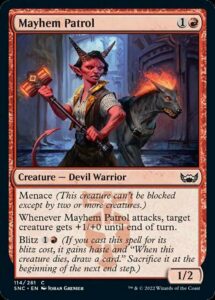
And then, the awesome
Last, and best of all, is Blitz. The other four mechanics strike me as pretty perfect for a five faction set as they’d all present issues being a major mechanic for an expansion; Blitz, however, is awesome. It’s a bit complicated in that it involves triggered abilities and gaining rules text, but it plays beautifully. It’s based on Dash from Dragons of Tarkir, but Dash is a repetitive effect—the creatures goes back to your hand, and so you Dash it again and again until your opponent makes the situation change. Blitz guarantees that the game state won’t be stale by getting rid of your creature and giving you something new to do in the form of card.
While Connive is all upfront complexity, Blitz is strong on its own while presenting several quests to the more enfranchised player. Can you create a situation where you force your opponent to block, giving you a 2-for-1? Can you sacrifice your creature to give yourself a 2-for-1? Can you Fake Your Own Death to keep your creature? While the mechanic certainly has complexity issues keeping it from being in the next introductory product and requires some structural support, I’m nevertheless a huge fan. I love that it’s an aggressive mechanic with a variety of synergies and quests and hope to see it return sooner rather than later.
And with that, we’ve covered Streets of New Capenna. Neither the mechanics nor the crime families were the stars of the show in Limited, and that made both harder to appreciate. Still, when you look past the issues, I see three perfectly fine mechanics with some issues, Alliance with heftier issues, and Blitz as a shining beacon of awesomeness. I feel the set tried to do too many things at the same time, while I paradoxically wish there was a sixth mechanic to tie the whole thing together as Morph did for Khans of Tarkir—which is an especially odd request from someone who critiqued both Innistrad sets for having six mechanics. (Granted, Streets of New Capenna did have a sixth mechanic in Cycling.)
With that, we close the chapter on Streets of New Capenna. Next week is MaRo’s State of Design, the article I most look forward to each year. I’m especially eager to see what he and Wizards think of the past year. But until then, as always, thanks for reading.
Zachary Barash is a New York City-based game designer and the last commissioner of Team Draft League. He designs for Kingdom Death: Monster, has a Game Design MFA from the NYU Game Center, and does freelance game design. When the stars align, he streams Magic (but the stars align way less often than he’d like).

